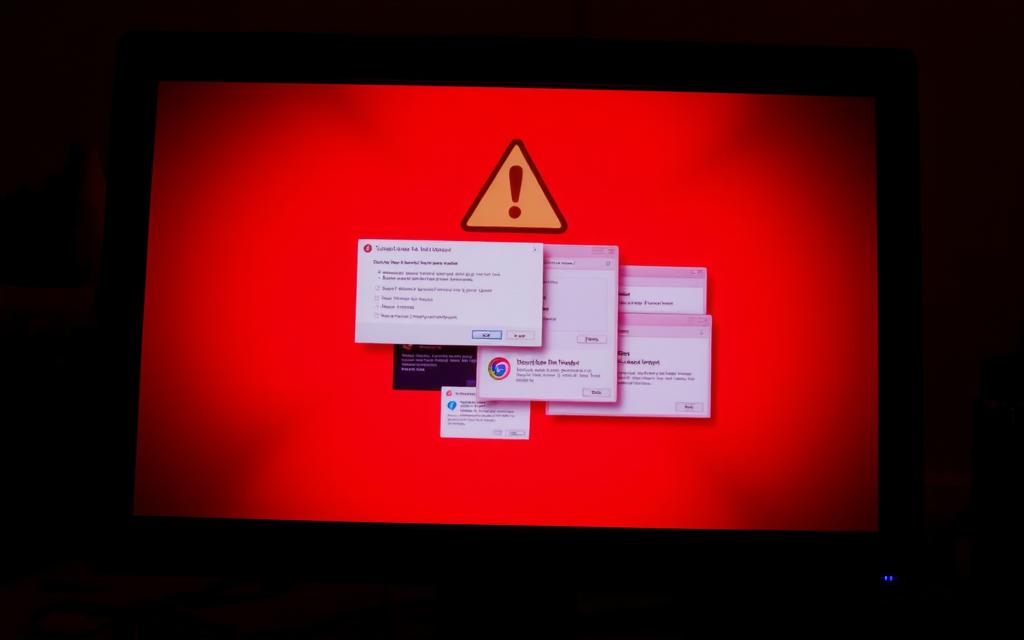Table of Contents
Seeing a “Your Device Has Been Locked” message can be alarming. These fake alerts often appear in your browser, claiming your system is infected. Scammers use fear to trick users into paying for fake tech support.
Acting fast is crucial. Microsoft warns that these malware scams can lead to financial loss. Some victims report demands for cryptocurrency payments. Never engage with the pop-up or call any listed numbers.
This guide covers safe removal steps for Windows, Mac, and Android. You’ll learn to close the alert using Task Manager and prevent future attacks. Follow these verified methods to protect your data and avoid remote access scams.
With 1 in 3 users encountering such fraud, knowledge is your best defense. Let’s explore the solutions.
What Is the “Your Computer Has Been Locked” Scam?
A sudden warning claiming your device is locked often signals a scam. These deceptive alerts mimic legitimate tech support messages from companies like Microsoft or Apple. Criminals use fear to trick users into surrendering personal information or payments.
How the Scam Operates
Fraudsters hijack browsers with full-screen pop-ups. These fake warnings claim viruses infected your system and demand immediate action. Many include a phone number for “assistance,” which connects to scammers.
Once contacted, criminals push remote software to access your computer. They may request payment via gift cards or cryptocurrency. Microsoft confirms genuine alerts never include contact details.
Common Tactics Used by Scammers
Psychological pressure is key. Fake countdown timers or threats of data deletion create urgency. Some pop-ups disable browser controls, trapping victims.
Other red flags:
- Requests to install security updates or utilities like Event Viewer
- Demands for credit card details under the guise of “verification”
- Spoofed caller IDs showing fake company names
Legitimate companies never ask for sensitive data through unsolicited alerts. Recognizing these patterns helps avoid costly mistakes.
How to Get Rid of Computer Lock Scam Immediately
Pop-up warnings blocking your browser require immediate action. These scams often disable navigation, trapping users. Quick intervention prevents further damage.

Terminate Suspicious Processes (Windows)
Press Ctrl+Alt+Delete and select *Task Manager*. Locate your browser under the *Processes* tab. Click End Task to close it forcefully.
For unresponsive systems, try these steps:
- Use a USB keyboard if laptop keys fail
- Disconnect internet to prevent page reloads
- Check for duplicate browser processes
Force Quit Applications (Mac)
Press Command+Option+Esc to open the Force Quit window. Select your browser and click the *Force Quit* button. Reopen cautiously in safe mode.
| Action | Windows Shortcut | Mac Shortcut |
|---|---|---|
| Close frozen app | Ctrl+Shift+Esc | Command+Option+Esc |
| Disable startup | Task Manager > Startup | System Settings > Login Items |
After closing the scam, run a security scan. Verify no unknown *applications* were installed. Reset your browser settings if needed.
Why Am I Seeing This Tech Support Scam?
Tech support scams often originate from compromised advertising networks. These fraudulent alerts appear when malware infiltrates your system or through malicious redirects. Understanding the sources helps prevent future threats.
Malware Infections
Malware can sneak into your device via:
- Fake software updates or pirated programs
- Infected email attachments or USB drives
- Drive-by downloads from hacked websites
Once installed, it hijacks browsers to display fake lock screens. Microsoft Defender SmartScreen blocks known malvertising campaigns, but zero-day exploits sometimes bypass it.
Malicious Ads or Redirects
Even legitimate sites can host harmful ads. Cybercriminals exploit ad networks to:
- Redirect users to phishing pages
- Trigger pop-ups mimicking operating system warnings
- Spread disguised downloaders
High-risk categories include free streaming platforms and adult content sites. Always verify URLs before clicking.
Signs Your Computer Might Be Infected
Your device acting strangely could signal hidden malware. Unusual behavior often appears before a message or pop-up demands action. Pay attention to these subtle warnings to avoid larger problems.

Unexpected Browser Changes
Hijacked browsers alter settings without permission. Common red flags include:
- New toolbars or search engines you didn’t install
- Links redirecting to unfamiliar sites
- Homepage changes that revert after correction
Check installed extensions regularly. Remove any with suspicious permissions or unknown publishers.
Unwanted Programs or Pop-Ups
Unwanted programs drain resources and create security gaps. Look for:
- Unknown apps in your system tray
- Sudden slowdowns during simple tasks
- Pop-ups promoting fake antivirus tools
| Issue | Quick Check | Where to Find Help |
|---|---|---|
| Browser hijacking | Review settings > Default browser | Browser support forums |
| Unknown software | Control Panel > Programs | Microsoft Safety Scanner |
Performance drops often accompany infections. Monitor memory usage in Task Manager for unexplained spikes. Early detection prevents data loss.
Step-by-Step Removal Guide for Windows
Removing persistent threats from Windows requires a systematic approach. Proper tools and techniques ensure complete elimination of malicious software. Follow these verified methods to restore your system safely.
Step 1: Uninstall Malicious Programs
Begin by removing suspicious applications through Settings > Apps > Installed apps. Sort by installation date to identify recent additions. Unknown programs with recent dates often indicate threats.
Key differences between removal methods:
- Control Panel: Shows legacy applications
- Settings app: Modern interface with search
- Right-click uninstall: Works for some stubborn apps
Step 2: Scan with Malwarebytes
Malwarebytes excels at detecting rootkits and advanced threats. Download the portable version to avoid installation conflicts. Enable these scan options for thorough checking:
- Rootkit scanning
- Memory processes analysis
- Startup item review
“Quarantine suspicious files instead of immediate deletion to prevent data loss from false positives.”
Step 3: Use HitmanPro for Deep Cleaning
HitmanPro provides cloud-assisted second-opinion scanning. Its unique features include:
| Feature | Benefit |
|---|---|
| Fast scan | Under 5 minutes for initial check |
| Hosts file repair | Fixes browser redirects |
| DLL injection prevention | Blocks future attacks |
After cleaning, review your settings for unauthorized changes. Reset browser configurations if needed. Regular scans help maintain Windows security.
Step-by-Step Removal Guide for Mac
Apple’s security features don’t make Macs immune to fraudulent threats. While macOS includes protections like Gatekeeper and XProtect, determined scammers find workarounds. Follow these steps to clean your device thoroughly.

Step 1: Check for Unwanted Applications
Open Finder and navigate to Applications. Sort by date added to spot recent installs. Delete suspicious items immediately. For deeper inspection:
- Check Login Items in System Settings (may hide auto-launching software)
- Review browser extensions for unknown add-ons
- Disable System Integrity Protection (SIP) temporarily via Terminal for stubborn files
Step 2: Run a Malware Scan
Use trusted tools like Malwarebytes for Mac or Bitdefender. These detect threats XProtect misses. Key actions:
- Enable kernel extension scanning for rootkits
- Verify signatures in Library/LaunchAgents folder
- Create a Time Machine backup before deletion—just in case you need help recovering data
“Gatekeeper blocks unverified apps by default, but users often override warnings. Always check developer certificates before installation.”
Reset Your Browser to Default Settings
Browser issues often persist even after removing malicious threats. Restoring default configurations clears hidden trackers and corrupted settings. This process varies across platforms but follows similar security principles.

Chrome Restoration Process
Google Chrome stores sync data separately from local configurations. Access reset options through Settings > Advanced > Reset settings. Key considerations:
- Cloud-synced elements may reappear – disable sync first
- Experimental flags reset to stable defaults
- Site-specific permissions and stored passwords clear
“Chrome’s refresh feature preserves bookmarks while removing harmful extensions. Always review restored data carefully.”
Firefox Reset Options
Mozilla offers two approaches through about:support:
| Method | Impact |
|---|---|
| Refresh Firefox | Keeps essential information |
| Complete reset | Removes all personalization |
Critical post-reset actions:
- Re-enable HTTP Strict Transport Security
- Verify certificate storage integrity
- Flush DNS cache through command prompt
Microsoft Edge Recovery
Edge’s reset button appears under Settings > Reset settings. The process:
- Eliminates malicious extensions completely
- Restores default content security policies
- Maintains enterprise-managed configurations
For stubborn cases, create a new browser profile. This changes your fingerprint while preserving access to essential websites. Always update protection preferences afterward.
How to Remove Scam from Android
Mobile devices face increasing threats from deceptive pop-ups and fake warnings. Unlike desktop systems, Android requires specific approaches to maintain security and remove unwanted content. Quick action prevents further complications.
Refreshing Browser Data
Start by clearing cached files that might contain malicious scripts. Navigate to Settings > Apps > [Your Browser] > Storage. Select both Clear Cache and Clear Data options.
Critical steps for different browsers:
- Chrome: Additional reset through Settings > Privacy and security
- Firefox: Includes site permission cleanup
- Samsung Internet: Removes tracking data separately
Mobile Protection Solutions
Trusted apps like Bitdefender or Malwarebytes offer specialized Android scanning. These tools detect:
- Hidden adware
- Fake security alerts
- Unauthorized background services
| Security Feature | Activation Method |
|---|---|
| Google Play Protect | Play Store > Profile > Play Protect |
| App Verification | Settings > Security > Google Play Protect |
| Biometric Locks | Settings > Security > Device unlock |
For persistent issues, Google’s Security Checkup provides comprehensive device analysis. This identifies compromised accounts linked to your device.
Advanced users should review:
- Developer options for unusual activities
- Network permissions for suspicious apps
- Installed certificates in security settings
Factory reset remains the last resort for stubborn infections. Backup essential data before proceeding with this nuclear option.
Advanced Tools for Stubborn Infections
Persistent infections often require specialized tools beyond standard antivirus solutions. These advanced utilities target hidden processes and deeply embedded malware that evade conventional scans. When basic removal methods fail, these programs provide the extra power needed.
Using RKill to Stop Malware Processes
RKill terminates malicious background processes that interfere with security software. Unlike standard task managers, it bypasses common evasion tactics used by advanced threats.
Key features include:
- Pre-boot execution via Windows Recovery Console
- Detection of NTFS alternate data streams
- Master Boot Record verification
The tool creates a log file showing terminated processes. This helps identify recurring threats needing further attention.
AdwCleaner for Adware Removal
AdwCleaner specializes in eliminating persistent adware and potentially unwanted programs (PUPs). It scans areas often missed by antivirus solutions:
- Browser helper objects
- WMI subscriptions
- Group Policy hijacks
For comprehensive protection, combine it with professional anti-malware tools like Malwarebytes. This layered approach ensures complete coverage.
| Tool | Best For | Scan Depth |
|---|---|---|
| RKill | Active process termination | Memory and startup items |
| AdwCleaner | Adware/PUP removal | Registry and hidden files |
These utilities provide a systematic way to address complex infections. Always update them before use to ensure detection of the latest threats.
How to Protect Against Future Scams
Proactive security measures significantly reduce risks from online threats. While removing existing scams is crucial, preventing future attacks saves time and protects sensitive data. Layered protection combines built-in tools with smart browsing habits.
Activating SmartScreen Protection
Microsoft Defender SmartScreen filters malicious websites and downloads before they reach your system. This free feature comes enabled by default in Windows 10/11. Verify its status through:
- Windows Security > App & browser control
- Edge settings > Privacy, search, and services
- Group Policy Editor for enterprise configurations
“SmartScreen blocks 99% of phishing attempts when properly configured. Regular updates maintain its effectiveness against evolving tactics.”
Implementing Ad Blocking Solutions
Quality ad blockers like AdGuard or uBlock Origin prevent malicious scripts from loading. These software tools:
- Filter out malvertising networks
- Disable auto-play video traps
- Block third-party trackers
For comprehensive protection, combine with DNS filtering services. This adds another security layer at the network level.
| Security Layer | Implementation | Protection Level |
|---|---|---|
| SmartScreen | Windows Settings | High (Microsoft verified) |
| Ad Blockers | Browser extension | Medium (User-configurable) |
| DNS Filtering | Router/Device settings | Network-wide |
Additional measures provide extra help against sophisticated attacks:
- Enable User Account Control (UAC) for admin prompts
- Configure firewall rules to limit unnecessary access
- Use hardware security keys for critical accounts
Regularly review these settings to maintain optimal protection. Security works best when multiple systems work together seamlessly.
What to Do If You Called the Scammers
Contacting scammers by mistake requires swift protective actions. Even brief interactions can expose your personal information or grant access to your devices. Follow these steps to contain potential damage.
Terminate All Remote Connections
Scammers often use tools like TeamViewer or AnyDesk. Uninstall these immediately through Settings > Apps. For persistent software:
- Rotate your TeamViewer ID in account settings
- Change RDP ports if remote desktop was enabled
- Check router settings for open VPN configurations
Reboot your device in safe mode to prevent automatic reconnections. Monitor network activity for unusual outbound traffic.
Secure Financial and Online Accounts
Assume any shared credit card details are compromised. Take these protective measures:
- Enable fraud alerts with your bank
- Place credit freezes at all three bureaus
- Replace payment methods saved in browsers
“Banks typically cover fraudulent charges reported within 60 days. Document all communications for dispute filings.”
| Action | Time Sensitivity |
|---|---|
| Card cancellation | Immediate |
| Password changes | Within 24 hours |
| 2FA replacement | Before next login |
For ongoing help, report incidents to the FTC and consider identity theft protection services. Support groups like Scam Survivors provide recovery guidance.
Conclusion
Staying safe online requires awareness and the right tools. Whether using Windows, Mac, or mobile devices, consistent security practices prevent most threats.
Recognizing scam tactics helps avoid costly mistakes. Fake alerts often pretend to be urgent system warnings. Always verify through official channels.
For ongoing support, bookmark trusted resources like the FTC scam reporting site. Quick reporting helps protect others from similar fraud attempts.
Tech safety evolves constantly. Enable automatic updates for operating systems and antivirus programs. This maintains protection against new threats.
Keep your digital life in order with regular backups and password management. These simple habits create resilience against attacks. Stay vigilant and share knowledge to build safer online communities.
FAQ
What should I do if a fake "Your Computer Has Been Locked" warning appears?
A: Do not call any listed numbers. Close the pop-up using Task Manager (Windows) or force quit the browser (Mac). Avoid clicking anything inside the message.
How can I tell if my device has malware from this scam?
Watch for unexpected browser changes, slow performance, or unwanted programs. Frequent pop-ups claiming system issues are another red flag.
Which tools remove tech support scams effectively?
A: Malwarebytes and HitmanPro scan for infections. For adware, AdwCleaner works well. Always download security software from official sites.
Why does this scam keep reappearing after removal?
Some infections modify system settings or hide in temporary files. Use RKill to stop active malware before scanning, then reset browsers to default.
Can Android devices get locked by these scams?
While less common, fake warnings appear on mobile browsers. Clear cache/data and scan with apps like Bitdefender or Malwarebytes for Android.
What steps protect against future attacks?
Enable Windows SmartScreen, use ad blockers, and avoid suspicious websites. Keep your operating system and security software updated.
I called the scammers—what now?
A: Disconnect your device from the internet immediately. Check for remote access tools like AnyDesk or TeamViewer, uninstall them, and monitor credit card statements for fraud.









